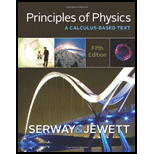
Concept explainers
(a)
The angle of refraction for the sound wave.
(a)
Answer to Problem 4P
The angle of refraction for sound wave is
Explanation of Solution
Given info: The wavelength of sound wave is
The speed of sound in air at
The expression for the Snell’s law is,
Here,
Rearrange the above formula to find
The formula to calculate speed of sound in water is,
Here,
Substitute
Substitute
Conclusion:
Therefore, the angle of refraction for the sound wave is
(b)
The wavelength of sound in water.
(b)
Answer to Problem 4P
The wavelength of sound in water is
Explanation of Solution
Given info: The wavelength of sound wave is
The formula to calculate the wavelength is,
Here,
Rearrange the above formula to find
Substitute
Conclusion:
Therefore, the wavelength of sound in water is
(c)
The angle of refraction.
(c)
Answer to Problem 4P
The angle of refraction is
Explanation of Solution
Given info: The wavelength of sodium yellow light is
The formula to calculate the Snell’s law is,
Here,
Rearrange the above formula to find
Substitute
Conclusion:
Therefore, the angle of refraction is
(d)
The
(d)
Answer to Problem 4P
The wavelength of light in water is
Explanation of Solution
Given info: The wavelength of sodium yellow light is
The formula to calculate the wavelength is,
Here,
Rearrange the above formula to find
Substitute
Conclusion:
Therefore, the wavelength of light in water is
(e)
The behavior of sound and light waves.
(e)
Answer to Problem 4P
The behavior of sound and light waves is that the sound waves speeds up when travelling from rarer medium to denser medium and light rays slows down.
Explanation of Solution
Given info: The wavelength of sodium yellow light is
The medium that has low refractive index with respect to another medium is called rarer medium and the medium that has high refractive index with respect to another medium is called denser medium.
From part (b) the wavelength of sound wave in water is larger than the wavelength of sound in air and from part (d) the wavelength of light in water is less than the wavelength of light in air.
The sound waves travelling from rarer to denser medium then the refracted sound waves bend away from the normal that the reason there is an increase in wavelength of sound waves.
The ray of light travelling from rarer to denser medium then the refracted rays bends towards the normal. So that’s the reason there is a decrease in the wavelength of light in water.
Conclusion:
Therefore, The behavior of sound and light waves is that the sound waves speeds up when travelling from rarer medium to denser medium and light rays slows down.
Want to see more full solutions like this?
Chapter 25 Solutions
Bundle: Principles of Physics: A Calculus-Based Text, 5th + WebAssign Printed Access Card for Serway/Jewett's Principles of Physics: A Calculus-Based Text, 5th Edition, Multi-Term
 Principles of Physics: A Calculus-Based TextPhysicsISBN:9781133104261Author:Raymond A. Serway, John W. JewettPublisher:Cengage Learning
Principles of Physics: A Calculus-Based TextPhysicsISBN:9781133104261Author:Raymond A. Serway, John W. JewettPublisher:Cengage Learning Physics for Scientists and Engineers: Foundations...PhysicsISBN:9781133939146Author:Katz, Debora M.Publisher:Cengage Learning
Physics for Scientists and Engineers: Foundations...PhysicsISBN:9781133939146Author:Katz, Debora M.Publisher:Cengage Learning University Physics Volume 3PhysicsISBN:9781938168185Author:William Moebs, Jeff SannyPublisher:OpenStax
University Physics Volume 3PhysicsISBN:9781938168185Author:William Moebs, Jeff SannyPublisher:OpenStax Physics for Scientists and EngineersPhysicsISBN:9781337553278Author:Raymond A. Serway, John W. JewettPublisher:Cengage Learning
Physics for Scientists and EngineersPhysicsISBN:9781337553278Author:Raymond A. Serway, John W. JewettPublisher:Cengage Learning Physics for Scientists and Engineers with Modern ...PhysicsISBN:9781337553292Author:Raymond A. Serway, John W. JewettPublisher:Cengage Learning
Physics for Scientists and Engineers with Modern ...PhysicsISBN:9781337553292Author:Raymond A. Serway, John W. JewettPublisher:Cengage Learning College PhysicsPhysicsISBN:9781305952300Author:Raymond A. Serway, Chris VuillePublisher:Cengage Learning
College PhysicsPhysicsISBN:9781305952300Author:Raymond A. Serway, Chris VuillePublisher:Cengage Learning





